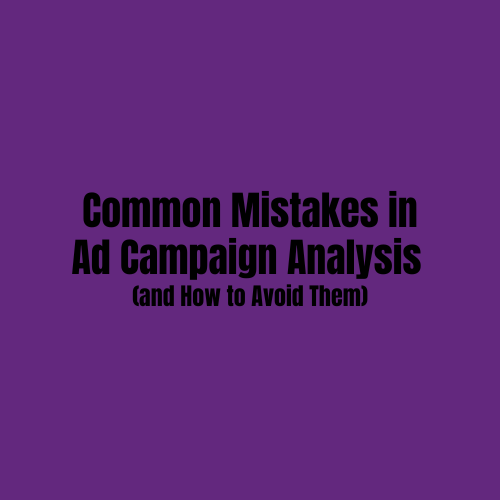Analysing ad campaigns effectively is crucial for marketers looking to optimise their efforts and maximise ROI. However, several common mistakes can hinder the accuracy and usefulness of this analysis. Here, we’ll explore these mistakes and provide strategies to avoid them, ensuring your ad campaign analysis is both insightful and actionable.
1. Focusing Solely on Vanity Metrics
Mistake: Vanity metrics such as likes, shares, and impressions can be appealing due to their high numbers and easy visibility. However, they don’t always correlate with actual business goals like conversions or sales.
How to Avoid:
- Identify KPIs: Determine key performance indicators (KPIs) that align with your business objectives. These could include conversion rates, cost per acquisition (CPA), or return on ad spend (ROAS).
- Prioritize Actionable Metrics: Focus on metrics that provide insights into customer behavior and campaign effectiveness, such as click-through rates (CTR), conversion rates, and customer lifetime value (CLV).
2. Neglecting Audience Segmentation
Mistake: Treating all audience members as a single homogeneous group can lead to ineffective messaging and targeting, reducing the overall impact of your campaign.
How to Avoid:
- Use Detailed Segmentation: Segment your audience based on demographics, behaviours, and psychographics. Utilise tools like Google Analytics or Facebook Audience Insights to gather detailed information.
- Tailor Your Messaging: Develop customised messages for each segment, ensuring your ads resonate with the specific needs and interests of different audience groups.
3. Ignoring the Full Customer Journey
Mistake: Focusing on just one stage of the customer journey (e.g., awareness or conversion) without considering how different stages interact can provide an incomplete picture of your campaign’s effectiveness.
How to Avoid:
- Map the Customer Journey: Outline the full customer journey from initial awareness to post-purchase. Identify key touchpoints and metrics for each stage.
- Analyse Holistically: Evaluate how your ad campaigns impact each stage of the journey, from attracting new leads to nurturing existing customers and encouraging repeat purchases.
4. Overlooking Data Quality
Mistake: Basing decisions on inaccurate or incomplete data can lead to incorrect conclusions and ineffective strategies.
How to Avoid:
- Ensure Data Accuracy: Regularly audit your data sources to ensure accuracy. This includes verifying tracking codes, ensuring consistent data entry practices, and eliminating duplicate or irrelevant data.
- Utilise Reliable Tools: Use trusted analytics tools and platforms to collect and analyse your data. Cross-check data from multiple sources when possible.
5. Failing to Test and Optimise
Mistake: Running ad campaigns without testing different variations or optimising based on performance can lead to missed opportunities for improvement.
How to Avoid:
- Implement A/B Testing: Regularly test different ad elements, such as headlines, images, and CTAs, to determine what resonates best with your audience.
- Continuous Optimization: Use the insights gained from testing to continuously refine and optimize your campaigns. This could involve adjusting targeting, tweaking ad creatives, or reallocating budget towards higher-performing ads.
6. Neglecting Cross-Channel Analysis
Mistake: Analyzing ad campaigns in isolation without considering their performance across different channels can limit your understanding of their overall impact.
How to Avoid:
- Integrate Data Across Channels: Consolidate data from various marketing channels (e.g., social media, email, search) to gain a comprehensive view of your campaign performance.
- Evaluate Synergy: Assess how different channels complement each other and contribute to the overall success of your campaigns. Look for patterns and insights that can inform your cross-channel strategy.
7. Relying Solely on Automated Reports
Mistake: While automated reports can save time, relying on them exclusively can lead to a superficial understanding of your campaign performance.
How to Avoid:
- Deep Dive Analysis: Complement automated reports with in-depth, manual analysis. Take the time to explore data trends, investigate anomalies, and draw nuanced conclusions.
- Customise Reports: Tailor your reports to focus on your specific goals and KPIs. Highlight key insights and actionable recommendations.
8. Ignoring External Factors
Mistake: Failing to consider external factors such as market trends, seasonality, and competitor actions can lead to inaccurate interpretations of your campaign’s performance.
How to Avoid:
- Contextualise Your Data: Always analyse your campaign performance within the broader context. Monitor industry trends, competitor activities, and external events that might impact your results.
- Adjust Accordingly: Be prepared to adjust your campaigns based on external factors. For example, if a major competitor launches a new product, you might need to tweak your messaging or increase your ad spend.
Conclusion
Avoiding these common mistakes in ad campaign analysis requires a strategic approach and attention to detail. By focusing on actionable metrics, segmenting your audience, considering the full customer journey, ensuring data quality, testing and optimising, integrating cross-channel analysis, complementing automated reports with manual insights, and contextualising your data, you can gain a more accurate and valuable understanding of your ad campaigns. This, in turn, will help you make informed decisions, optimise your marketing efforts, and ultimately drive better results for your business.



